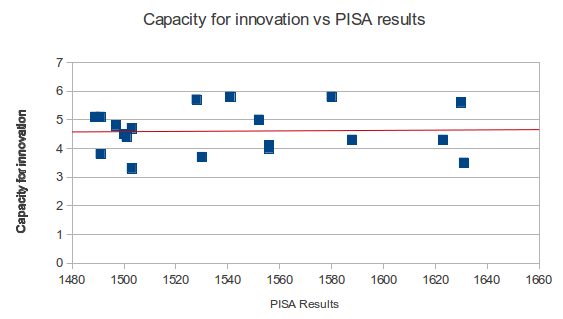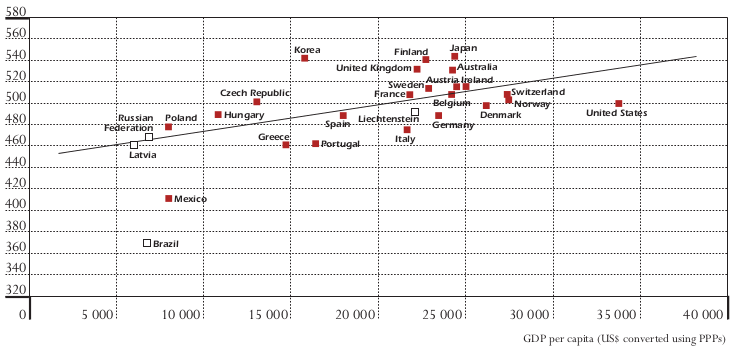In an earlier post I reported on the downward trend in the Swedish PISA results [1] (PISA is a survey measuring student knowledge and skills) and contrasted these with the overall competitiveness and innovativeness of Sweden. In a recent issue of The Economist [2] the prime minister of Singapore, Lee Hsien Loong, is reported to recommend parents to let their children play instead of doing too much homework based on a fear that…
…hard-studying Singaporeans lack creativity and an ability to think laterally. This is now seen as a competitive disadvantage in what are often called “knowledge economies”, where innovation and inventiveness are at a premium.
Now things are not all that bad in Singapore, at least not yet. Singapore came third right behind Sweden in the Innovation Index survey and second, right before Sweden in the competitiveness survey. But when looking at one core component of the Innovation Index, capacity for innovation (see chart below for a definition), things don’t look too good for Singapore which ends up as #22 while Sweden is #4, very close to the top players Japan, Switzerland and Germany. In fact, looking at the top 20 PISA countries there is hardly any correlation between overall PISA results and capacity for innovation (see graph below).

A couple of observations that give some hope to us parents of pampered Swedish students and to our whole mediocrely educated country:
- It seems that a student body that excels at reading, math and science tests is not a prerequisite for a country’s industry to be innovative. I recognize that there might be a lag between a class of good students and their impact in the industry but Sweden has not been among the top 10 PISA countries in any survey since the year 2000 but is still very innovative.
- The PISA survey from year 2000 contains a graph of PISA results vs national income (from the same year) but wasn’t it not for a couple of outliers, the correlation would not be a strong one. In fact, there actually seems to be a slightly negative correlation between PISA and GDP above a certain level of GDP. See graph below.
- Finland gets a higher total PISA score than both Singapore and Korea but with a lot of outdoor play, no cramming and hardly any homework [3]. I still don’t understand why Sweden (or any other country for that matter) doesn’t shamelessly copy the Finnish way.

Play, learn, innovate!
Links
[1] 2009 PISA survey results.
[2] Tiger mothers in Singapore.
[3] Why Are Finland’s Schools Successful?
Note
Having written this post I heard a report on the Swedish radio from China where many teachers, parents and headmasters expressed a worry about the Chinese education system that was said to be too focused on the university entrance exams, Gaokao. “Too much knowledge and too little wisdom” was one comment. Several of the interviewed educators had been to Sweden and brought several ideas with them back to China.